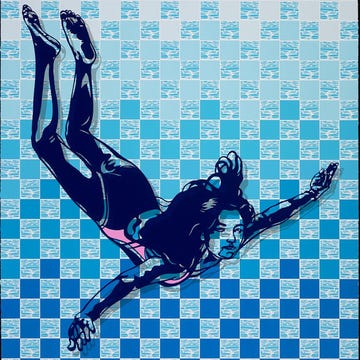Sci-fi, Magick, Queer L.A.: Sexual Science and the Imagi-Nation at the USC’s Fisher Museum of Art in Los Angeles is an invitation to another world. Running through November 23, the show presents paintings, magazines, photographs, films, and costumes created in the overlapping worlds of L.A.’s mid-20th-century occult scene, science fiction fandom, and queer underground.
This essay was adapted from the Alta Weekly Newsletter, delivered every Thursday. To keep reading, become an Alta Journal member for as little as $3 a month.
SIGN UP
In one gallery devoted to magick (the k distinguishes occult practice from sleight of hand), three smoky paintings by Renate Druks (1921–2007) set the tone. In Spring Fever, a bare-breasted woman wreathed in fog and crowned with a bird’s nest (complete with egg) holds a vine that has grown around her body. A yellow-eyed black cat crouches at her feet. The painting is paired with an LP soundtrack to the science fiction film Forbidden Planet, for which Druks did the cover art.
Curated by Alexis Bard Johnson (with Kelly Filreis and Quetzal Arevalo), the exhibition makes the connections among queerness, fan clubs, and the ritual magick explicit. “Sci-fi fan clubs and occult gatherings...were already secretive enclaves, seen as so weird or silly as to be beneath reproach—meaning they were effectively ignored,” writes Joseph Hawkins in the handsome catalog that accompanies the show. This made them safe places for queer people to find community and one another in the pre-Stonewall era.
Many of the artists, writers, and filmmakers featured in the show were transplants to Los Angeles, arriving in the 1930s, ’40s, and ’50s seeking new lives, identities, and communities. One such figure was Edythe Eyde (1921–2015), known also by her alter egos Tigrina the Devil Doll and Lisa Ben (an anagram of lesbian). A secretary at RKO Pictures, Eyde was the creator of Vice Versa, the first lesbian magazine. Having fled then-rural Palo Alto, Eyde joined the Los Angeles Science Fantasy Society, where she met aficionados like Jim Kepner, a journalist and historian whose collections are included in the ONE Archives, which describes itself as “the largest repository of Lesbian, Gay, Bisexual, Transgender, Queer (LGBTQ) materials in the world.”
The person who epitomizes the intersection of science fiction, occult ritual, and queerness is the artist Cameron (1922–1995). Born Marjorie Cameron, she was a navy cartographer from Iowa who moved to Pasadena, took up painting, and married Jack Parsons (born Marvel Whiteside Parsons, 1914–1952), a rocket scientist whose work helped found the Jet Propulsion Laboratory and an avowed occultist.
Parsons believed he had summoned Cameron into his life via a ritual he undertook with his sci-fi author friend, a pre-Scientology L. Ron Hubbard. Together, Parsons and Cameron practiced the religion Thelema, created by Aleister Crowley.
Following Parsons’s death in a mysterious explosion in his garage, in 1952, Cameron moved close to the Mojave Desert (and, later, back to L.A.). She collaborated with queer filmmakers Kenneth Anger and Curtis Harrington, who made a short film about Cameron, The Wormwood Star, which plays at one end of the magick gallery.
Cameron’s marriage to Parsons is often depicted as a star-crossed love affair, after which the bereft widow spent the rest of her days trying to reunite with her lost husband through ritual magick and her own art practice. It’s an appealing vision that softens the labyrinthine strangeness—and the intensity—of Cameron’s art and magickal practices, but it’s not the whole story.
Cameron’s relationship to her own legend and that of her late husband was complex, says Scott Hobbs, an Iyengar yoga instructor who became Cameron’s friend and adviser in the 1980s and today runs the Cameron Parsons Foundation. “[Cameron] resented the fact that people would come to her to talk about Jack. She felt like at a certain point she was an equal,” Hobbs tells me. “She expressed her magick through her art, but her art pretty well stands on its own.”
As Hobbs went on to explain, Cameron didn’t like to show her work, since “she felt like galleries prostituted artists.”
I first saw Cameron’s art a decade ago in Cameron: Songs for the Witch Woman, a show at the since-shuttered MOCA Pacific Design Center in West Hollywood. Stunned by the art—particularly the pain-filled, transcendent faces of her East Angel and West Angel—I took to the internet to see what had been written about the show and found a Los Angeles Times review by Christopher Knight that was typically dismissive. “Cameron was pretty much socially limited to the role of men’s muse. Her work is thus rather thin,” Knight wrote.
In my own life, magick, science fiction, and queerness have also collided. Standing in front of Cameron’s paintings in West Hollywood in 2015 had been a pivotal moment for me. Cameron’s art reconnected me with a lost part of myself, the child who loved stories about other worlds and invented her own rituals with a candle, mirror, and blade—an elegantly engraved letter opener that had once belonged to my great-grandmother. Seeing it again in 2024, I felt how far I have traveled into the world I invoked in those spells, the way Cameron’s powerful visions led to this very moment.•
Lisa Locascio Nighthawk is the chair of the Antioch MFA and the executive director of the Mendocino Coast Writers’ Conference. Her work has appeared in the Believer, the New York Times, and Electric Literature. Her first novel, Open Me, was published by Grove Atlantic in 2018. She writes a newsletter called Not Knowing How.












